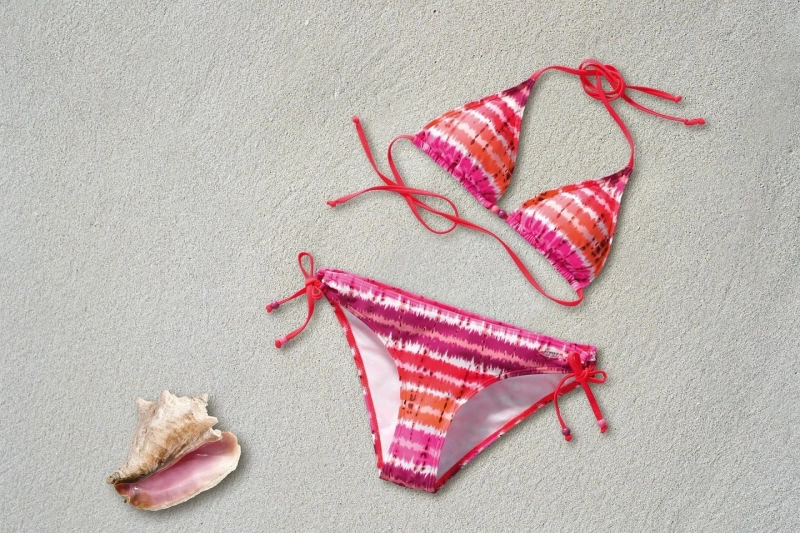From upcycled polyester to reused water bottles, H&M’s new recycled swimwear brand has got the high street talking and it’s about time. Fast fashion continues to dominate our favourite high street brands, with a modern-day fashion industry pumping out over 80 billion garments a year, 10 for every person on earth.
In response to this, large fashion giant H&M has risen up amongst the ranks, to launch a swimwear collection that has the environment in mind. Paving the way for the future of fashion, their stunning collection of bandeaus, curved briefs and off the shoulder silhouettes are made from recycled polyester, textile waste and recycled bottles.
Launching now across their high street and online stores, this new fashion statement could send a message out to their high street partners. Head of design, Maria Östblom called this their “most sustainable swimwear collection thus far” telling readers in a recent interview that the size-inclusive designs were made out of “85% recycled polyester”.
Could this be the beginning of a new era of fashion? One that is not only inclusive of all body types but environmentally conscious too? Read on to find out why fast fashion needs to become a habit of the past, and how you can start shopping sustainably.
Why Is Fast Fashion So Damaging?
Fast fashion is currently dominating our clothing market. As a cheap and effective way to produce clothing and rake in revenue, many high street brands turn to mass production of poor quality indisposable clothing in order to keep up with the latest styles and trends.
The ever-changing Gen Z trends are only fueling the problem, with many garments falling ‘out of fashion’ within the first few months of purchase. In fact, the global waste charity, TRIAD state that the average garment is only worn 10 times before it is retired and thrown away.
The question is, just how much damage is this causing to the environment? With cheaper garments fueling the incentive to buy into fast fashion, the consequences for the earth and water around us is astonishing.
For example, it’s predicted that some garments of clothing can take up to 200 years to fully decompose, polluting landfills, oceans and natural habitats. In fact, it’s not only the physical clothing but the dye that can cause the most damage, especially in aquatic environments.
With cheap clothing containing substances such as arsenic and lead, which are highly harmful to aquatic environments, fast fashion ranks as the number one polluter of our waters. In Bangladesh, the home of fast fashion production, we see 22,000 tons of toxic waste slip into the ocean as a result of mass wastewater from clothing factories being dumped directly into rivers.
Alongside this, high street brands have some of the largest global carbon footprints in the world, thanks to the wasted energy caused by fast fashion production. According to Greenpeace’s Journal Unearthed, as fast fashion continues to grow at the alarming rate it currently is, we could see our clothing’s carbon footprint rise to 26% by 2050.
How Are High Street Brands Tackling Fast Fashion?
For many large high street giants, it took the Rana Plaza Disaster to start taking responsibility for their less than ethical supply chains currently mass-producing our favourite fast fashion. Three years after the building collapse in Bangladesh, killing over a thousand underpaid workers, Labour Behind The Label ran a ‘pay up’ campaign for high street companies to donate to in aid of those affected by the disaster and money to be put towards the environmental implications caused by mass fashion production.
In recent years, many high street giants have used this as a turning point, reducing their labour and introducing more conscious collections. H&M are one of these companies, supplying new eco-conscious ideas to their drawing board each fashion season. Another store striving towards sustainability is M&S, which has recently stated that they aim to procure 70% of their cotton from ethical sources.
As great as these small steps are, in terms of the future of fast fashion there is still a long way to go. As the death of the physical high street creeps closer, online retailers are becoming the most problematic, with a record-breaking turnover of fashion.
Eco-Friendly Alternatives To The High Street
If you’re looking to shop more sustainably and make ethical choices when choosing your next outfit, keep reading to find out how you can incorporate sustainability into your next clothing haul.
A New DIY Generation
In a post-Covid landscape, DIY has become the hobby of the nation. From household items to repurposed clothing, upcycling is in. One of the easiest ways to reduce your fashion footprint is to simply make your clothes last. With thick cotton material, most garments are designed to last years rather than months.
As an eco-friendly alternative to fast fashion, why not follow that latest Gen Z trend and start moulding older pieces into new styles that fit with this season. In fact, most of the Gen Z trending pieces are vintage or upcycled designs, with a younger population now more focused on environmental issues such as climate change, most of the new season’s styles reflect your ethical energy from the get-go!
(Source: Statista)
Sustainable Collectives
Shopping small and locally is also key if you need to buy something new. Try ethically sourced clothing brands such as Lucy & yak and House Of Sunny for long-lasting sustainable designs. From garments, all the way to eyeglasses, shopping with an eco-brand allows you to receive the best quality products that may cost a little more but will last a lifetime.
For unique and original designs, why not also join the vintage craze currently taking over the high street. From to be worn again shops to charity shops and vintage designers, the range of clothing is endless, saving both your pocket and the planet!


